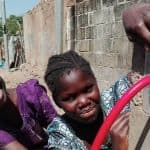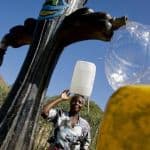The Other ‘Shark Tank’: A High-Stakes Effort to Find Solutions to the Global Water Crisis
In just three decades from now – a blink of an eye in the scope of human history – nine billion people around the world will need clean water and food, on a planet where water shortages and food shortages already affect more than 2 billion people per year. We have no silver bullet to address what could be a worldwide crisis, one impacted by climatic variation and natural disasters.
This predicament led to an international competition, bringing together global innovators to tackle food and water shortages. One could compare the competition to the popular network television program “Shark Tank,” though in this case, the stakes are far higher. This competition is about life, human survival and the planet’s future. It is about innovators in far-flung locales developing water-saving, crop-enhancing solutions for struggling farmers, many of whom are women working the fields while their husbands often work in cities.
An Ambitious Program Tackling a Global Problem
Six years ago, faced with global forecasts of water scarcity, a group of international donor agencies came together to create the Securing Water for Food (SWFF) Grand Challenge for Development. They included the United States Agency for International Development (USAID), and the governments of Sweden (through the Swedish International Development Cooperation Agency), the Netherlands and South Africa.
It was an ambitious program that aimed to make a dent in a vexing problem. The idea was to create practical approaches that could address a looming crisis, while also helping people be self-reliant. That meant the innovations needed to succeed, even without counting on future donor funding. This was a tall order. Each donor organization and a panel of technical and subject matter experts participated in selecting the innovations that would receive funding through the Challenge.
The donor agencies felt that it was important that the businesses and projects — whether for-profit or non-profit — continue on their own and become more self-reliant.
Surviving the ‘Shark Tank’
Some 1,500 applicants entered the donors’ “Shark Tank” through four separate calls for innovations, though these “sharks” were not well-heeled entrepreneurs and television personalities. Instead, they were sector-specific experts, women and men, who judged the applicants’ technologies and business models on their technical feasibility, financial viability, gender (ie: whether they were inclusive of women) and commercial sustainability — and the possible and probable results that these applicants could achieve if accepted into the program.
The process to winnow down qualified applicants was rigorous, from an initial one-page concept to a several-page application to, finally, a video interview for those few who were fortunate to make the cut, in which they were grilled by the evaluation team with the same intensity that you would see on the Shark Tank show. In the years since the Challenge’s launch, this process has led to 40 total grants awarded, of which 26 have been considered successful, having either met or exceeded goals set during the application process. The SWFF program completed all of the calls for innovation and is scheduled to end in May 2020. A follow-up challenge fund called the Water and Energy for Food Grand Challenge is expected to launch in June 2019.
From the outset, the program thought success could be reported if it funded 50 organizations and 10 succeeded. In a project like this, it would be normal to have one success story out of 100. The projects are global, but almost all are concentrated in areas with severe water issues, such as monsoon flooding and drought, including Bangladesh, Vietnam, Cambodia, India, South Africa, Uganda, Ghana and Kenya, among others. They range from a ground-breaking idea to plant crops on desolate sandbars left after monsoons in Bangladesh to water storage for irrigation during dry periods in India to a mobile app for texting precise weather forecasts to farmers in Vietnam.
Unexpected Successes and Outsized Impacts
With respect to impact, SWFF program results are particularly encouraging and conclusive. As reported in the recent Dexis program evaluation that conducted a comprehensive study of 21 of the 40 SWFF innovations in seven countries: “SWFF strongly contributed to outcomes: an analysis of surveys found that ninety percent of beneficiaries have improved access to water and ninety-five percent water efficiency directly due to SWFF’s innovations.” Dexis also concluded that SWFF has great relevance, is effectively run, has effective oversight, is efficiently set up, is making significant impact and is progressively moving toward greater sustainability.
Success at the Local Level
Imagine a SWFF innovator walking along a river bank in Bangladesh, pondering the fact that monsoons yearly cause farmers to abandon their homes and land. He suddenly comes up with a ‘what if?’ idea. The result: planting pumpkin, squash and other crops on sandbars that exist for several months after the flooding. The story continues with the farmers growing crops for food on that sandbar, using much for the family, but having enough left to sell, buy a motorbike for transportation and send children to school with cash received. That’s what the SWFF program is all about.
The Challenge initially envisioned positively impacting three million farmers and families. This program has already impacted more than 6 million people. Compared to traditional ways of reducing water use, the program hoped to cut water consumption by 7 billion additional liters. Instead, our innovators have cut it by 18 billion liters.
Similarly, at the program’s inception, the program believed that innovators could help farmers grow an additional 1.9 million tons of food. Now, innovators have help farmers grow more than six million tons of food. The innovators have been able to grow yields by an average of 10 to 15%, though some have doubled or tripled their yields.
Not every innovator, of course, has been a success story, but often this has been due to natural disasters impacting their ability to produce – or, in one situation, the threat of terrorism. Only in a few instances has lack of success been the result of personal failures, such as insufficient initiative on the part of innovators.
The televised version of “Shark Tank” is serious business to those who compete – and it can have a major impact on those who are fortunate enough to end up with a sizable investment. But notwithstanding its entertainment value, this impact doesn’t compare to the “Shark Tank” in which SWFF innovators have competed, where the stakes may very well be the survival of humanity on a planet with diminishing resources.
SWFF is not an entertainment reality show—it is a ‘real life’ drama, and therein lies the critical difference.
Dr. Ku McMahan is the team lead for Securing Water for Food.
Photo caption: SWFF innovator Ignitia, a weather forecasting startup, helps farmers in emerging markets with an SMS service that sends out localized forecasts via text message (e.g., “rain this morning, dry tomorrow”). The company claims a high accuracy rate of 84% and a forecast range of up to five miles. Photo provided by organization.
- Categories
- Agriculture, Environment, WASH



